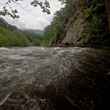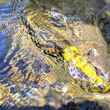I came so far for beauty,
I left so much behind.
—Leonard Cohen
I planned to make a night of it, fishing brookies on the sparkling upper river early in the evening then dropping down to a deeper, slower stretch after sunset in the hopes that Mr. Hex might appear—and that Mr. Big might join the party. I knew where the heavy brown lived and if anything could induce him to slide out from beneath his canopy of brush it was a hatch of Hexes, the biggest, juiciest mayflies on the continent.
First, though, I had an appointment with an endangered species. That was the hope, anyway.
I turned off the county highway, drove south on a secondary road for half-a-mile, and pulled over at a place where it appeared a ragged patch of sky had detached, fallen, and settled gently to earth. It was a field of spiky wild lupine in glorious full bloom, part of a relict oak savannah managed by the Wisconsin DNR as Karner Blue Meadow State Natural Area.
It’s a point of pride among those of us who live here, and who still care about such things, that Wisconsin’s State Natural Areas program was the first of its kind in the nation. Created for the far-sighted purpose of preserving the best remaining examples of the landscapes and habitats that characterized Wisconsin prior to settlement, the idea was championed, not surprisingly, by Aldo Leopold. The Leopold Shack, in fact, lies just 50 miles south and a little west of Karner Blue Meadow, the 140th SNA in the system.
More Like This
I’d barely gotten out of the Forester when a tom turkey flushed heavily from the edge of the lupines and hammered toward the broadly branched oaks, his wingbeats sounding like body blows, whump-whump-whump-whump. My professional pride was a bit wounded that I hadn’t spotted him on the ground but my mind was on far smaller game—specifically, the endangered butterfly for which this SNA is named.
About the size of a quarter, the Karner Blue depends entirely on wild lupine for its survival. And with the oak savannahs, pine barrens, and other mixed woodland-grassland landscapes that were historically carpeted with lupine reduced to scattered remnants, populations of this tiny flyer have crashed.
Indeed, despite reading and even writing about the Karner Blue for years, I’d never seen one except in photographs. I wanted desperately to remedy this deficiency but now, wading among the knee-high flower stalks (and doing my best to trample as few of the non-flowering plants as possible), all I saw were bumblebees, dozens of them, as fat as lords and presumably as happy.
After a while I reluctantly turned and headed back to the car. Karner or no, the clock was ticking. I wanted a crack at those brookies, and the Hex, as is well-documented, waits for no man.
Then I caught an impression of movement out of the corner of my eye. Something was fluttering around a couple feet to my left, and for a moment I was tempted to dismiss it as some sort of small, nondescript moth.
That’s when it hit me, if not like a thunderbolt at least like a slap to the face, that I was undoubtedly looking at my first-ever Karner Blue butterfly.
It soon landed on a lupine, where, easing closer but still maintaining a respectful distance, I was able to identify it as a female. The male Karner is an incandescent blue—not unlike an indigo bunting, if you’re familiar with that astonishingly plumaged songbird—but while the female’s colors are softer their subtlety and intricacy are breathtaking. Dun wings dusted as with by fine blue pollen, a decorative motif of orange crescents on their trailing edges and a fringe of delicate ivory all around … It seemed the kind of object that might have been discovered in the tomb of a pharaoh, an exquisite jewel whose miniature dimensions served only to concentrate and intensify its extraordinary beauty.

'I counted myself lucky, and privileged, and thankful to have had this opportunity. It’s not every day that you can leave home with the express intention of laying eyes on an endangered species—especially one so notoriously evanescent—and have your wish come true.
A little while later and just a few miles away, I counted myself lucky, and privileged, and thankful once again. Fishing the narrow headwaters of this river that springs cold and clear from the central Wisconsin sands, I fooled a trio of brookies—all native, all wild, and all hypnotically beautiful, their dark cloaks spun of mystic runes and occult enchantments. Laid end-to-end-to-end, they might have measured twenty inches. A few days earlier the Wisconsin Attorney General had essentially ruled that irrigating potatoes is a higher priority than maintaining streamflows, a decision with terrifying implications for trout and one that only deepened my appreciation for the miracle that is a native brookie.
I flushed a hen wood duck, too, also a drake mallard, and every few minutes a ruffed grouse would fire up, drumming his heart out from the greening understory.
Is there anything not to like about any of that?
I was using an outfit recommended to me by an old Yooper for snaking brookies out of impossible places: the tip section of a longish two-piece trout rod, with about five feet of 5X tippet clinch-knotted to the tip-top.
Trailer-park Tenkara, you might call it.
Basically I just scouted for likely looking holes, and when I found one I stuck the rod tip through the brush and plopped my fly, a #14 Beadhead Hare’s Ear, into the drink. OK, so maybe I took another piece of advice from the old Yooper and sweetened the pot with a bit of garden hackle. I dug the worms from my own compost pile, and I think I deserve some credit for that.
Besides, I wasn’t angling for any style points; I was angling for a meal of fresh brook trout prepared the way I like them: dredged in seasoned flour, laid in sizzling-hot bacon grease (in a cast-iron skillet, of course), and fried until the skin crisps, the flesh steams, the small bones soften, and what’s left when you’re done wouldn’t turn the head of a seagull. With a side of fried potatoes and onions (potatoes out of a can are best) and a bottle of cold Wisconsin lager (Point or Leinenkugel’s), it’s rapturously good, utterly unimprovable, and something you can’t buy, for any price, at any restaurant in the world.
Unlike potatoes, which, the last time I shopped for groceries, were five pounds for 99 cents.
But that would be tomorrow’s pleasure. Now the sun was gilding the crowns of the pines, and I had to get halfway across the county, fast. The day had been warm and humid, setting up ideally for an emergence of the giant nocturnal mayfly that makes trout and men alike go a little crazy.
Doing my best Jackie Stewart imitation as I dodged deer and tortured the gearbox on those twisting country roads, I raced through the gloaming to my spot on the lower river. Mr. Hex did appear, and Mr. Big did come to the party. But that’s a sad tale, and this is a happy story. All you really need to know is that I said some bad words.































Comments